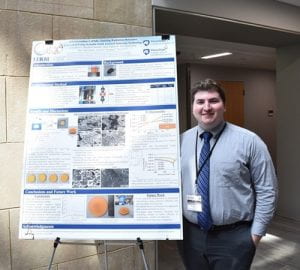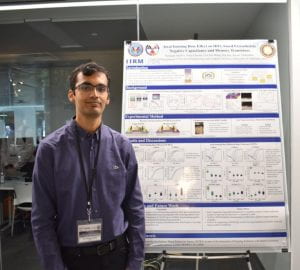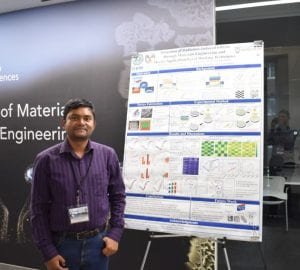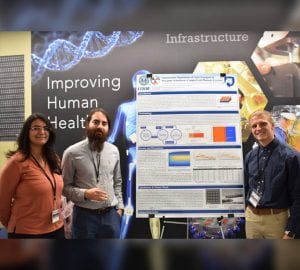Current Programs:
Three Minute Research Presentation
The three minute research presentation (TMRP) training and friendly competition was open to all IIRM-URA students conducting research. This program gave students the opportunity to communicate their research or dissertation as a captivating story, allowing them to share their work and its impact with a larger audience.
The 2025 TMRP competition was held at the Annual Technical Review on Wednesday, July 30th. All presentations were impressive!
Congratulations to the top finishers:
1st Place – Jackson C. Adler – Pennsylvania State University
2nd Place – Kalel Kai – University of MD at Baltimore Co.
3rd Place – Jason Yeager – Pennsylvania State University

Watch this space for information on the upcoming Fall 2025 Virtual Drone Competition!
IIRM Workforce Development
Science, technology, engineering, and mathematics (STEM) fields foster job opportunities today and in the future. Emerging mission requirements pose great STEM workforce challenges, underpinning the U.S. Department of Defense’s (DoD) ability to provide national security. IIRM-URA works to mitigate and prevent these challenges through its workforce development program.
The IIRM-URA workforce development (WFD) program’s vision is to combine creative, challenging technical projects with meaningful student-faculty, student-industry, student-national labs interactions, enabling a STEM workforce development pipeline.
The two key, interrelated components of the student pipeline development activity are (1) the development of effective, dynamic strategies for student recruitment, and (2) the development of a scalable framework of student sandbox processes and tools.
There are four main, interconnected thrust areas within the IIRM workforce development plan: rotations, teaching modules, outreach activities, and competitions.
Unmanned aerial vehicles (UAVs) are our chosen outreach platform, and there are many analogies to flight in all of our workforce development thrust areas. Successful quadcopter flight is all about the ability to provide even, complimentary energy to each of the four propellers, and the same can be said for our approach to balancing and managing each aspect of workforce development.
Thrust Areas
Rotations
The goal of the rotation thrust area is to advance, educate, and provide rotation opportunities for all Alliance members through short- and long-term temporary assignments across the Alliance to foster and facilitate collaboration and professional development.
Rotations take many forms, including student internships, faculty sabbaticals, visiting scholar positions, and hosting Alliance members at unique facilities to name a few. In 2021, the IIRM URA hosted 12 NSERC interns across five locations in the Alliance.
Learn more about the 2021 internship program here.
Teaching Modules
The teaching module thrust area where the research, basic science, and educational components of the entire IIRM alliance are introduced to workforce development. We are developing educational content tailored to secondary students, undergrads, graduate students, and research partners. In 2021, the IIRM URA began a seminar series designed to create and promulgate a series of lectures in IIRM technology areas, given by subject matter experts across the Alliance. Some of those modules are aimed specifically at our students in the outreach program, and to that effect, the teaching modules are the building blocks to outreach. The IIRM URA has partnered with PITSCO, a K-12 STEM-focused education and curriculum company, to build a series of teaching modules and activities for high school students that teach students IIRM relevant basic STEM principles by using a UAV platform.
Outreach Activities
Our outreach initiatives are focused on reaching students outside of the Alliance, with a focus on teaching IIRM and STEM concepts designed to inspire, guide, collaborate, network, and educate. Teaching STEM enables undecided students to make vital connections between everyday life and the STEM disciplines. It also lays down the foundations for future academic success because the skills learned are transferable to many subjects. There is also a direct connection between STEM education and mentorship and a higher rate of matriculation of underrepresented groups, like women, in college engineering and science majors.
Our approach with outreach is to bring IIRM teaching modules and competition frameworks to existing outreach programs across the Alliance in order to maximize our use of existing networks and student engagement.
A key outreach partner for IIRM is the Sea, Air, and Land Challenge (SeAL Challenge). The IIRM Workforce development team partnered with the SeAL Challenge to develop a new Air Challenge in 2023, and new Sea Challenge in 2024, where the missions were both IIRM and DTRA focused. Students are challenged to build a quadcopter for the Air Challenge with a payload (camera) that simulates a radiation sensor that allows first responders to safely determine if a recent explosion in a metropolitan area has released radioactive elements, and to drop markers on “hot spots” to indicate a radiation danger zone to serve as a warning to ground crews. The new Sea Challenge in 2024, has submersibles diving to retrieve cargo spilled containers filled with irradiated materials.
Sea Air and Land (SeAL) Challenge
The Sea Air and Land (SeAL) Challenge gives teams of students the opportunity to learn about the engineering process through the design of a robotics system relevant to the DoD. The web-delivered, low-cost program is one semester and available to graduates or those currently enrolled in a postsecondary program, provides engineering mentors and a choice of missions to student teams:
- Sea: Develop a submersible to locate and retrieve sunken cargo containers carrying radioactive materials.
- Air: Build a payload for a quadcopter that can determine if radioactive elements are present.
- Land: Build a robot that rescues animals caught in a wildfire.
Student Competitions
The goal of student competitions is to provide a fun, engaging platform for students to learn about science and engineering principles within the IIRM research areas: materials, devices, and survivability and response. The annual IIRM Student Challenge provides an educational opportunity for all students within the IIRM Alliance to learn more about some of the fundamentals of the research throughout the Alliance, in a fun, competition-based platform. The student challenge will be hosted each year at the IIRM Annual Technical Review.
The concept behind the competition is to take a platform—unmanned aerial vehicles—and use it as a delivery mechanism for teaching modules, or basic research/science or engineering concepts that are central to the work being performed in IIRM. We chose UAVs in collaboration with DTRA for multiple reasons:
- DTRA values the use of UAVs in their deter, detect, and defend mission against WMD.
- Unmanned platforms are an area of interest for students and an explosive area of growth in educational curriculum at the moment, and 3. We believe they are an excellent platform to build meaningful competitions and to foster collaborations between students and the IIRM Alliance.
In 2021, Penn State hosted the inaugural Student Challenge on a virtual platform. Students flew a UAV, or drone, in a simulated environment to learn about the fundamentals and real-life limitations of radiation sensors. Researchers from IIRM research devices and integration research area, provided the fundamental physics and scientific information to build in the learning component of this challenge.
These competitions have been held twice a year since then. The competition scenario or methodology has been updated every season, too, featuring a different IIRM research or focus area. In total, nearly 3000 students have taken part.
For further understanding of its offerings, the following is the flyer from the Spring 2025 virtual drone competition.
The educational goals for the competitions include:
- Learn about who DTRA is and how DTRA supports responses to a radiological threat
- Learn about the uses of UAVs and the basics of how to conduct UAV operations
- Learn the basics of flight for a UAV
- Receive basic education on radiation sensing technologies
- Learn some practical considerations for the use of radiation sensing technologies in the field (dwell time; establishing a background; sensor-based weight and power consumption)
- Understand the importance of mission planning, specifically the criticality of developing a plan prior to execution in order to succeed with respect to resource management.
Learn more about the inaugural 2021 competition here.
Student Poster Sessions
The Student Poster Session was held as part of the Annual Technical Review at USMA on July 29th, 2025 in West Point, NY. During the afternoon session, twenty-five students presented their research to the judges and attendees. Posters were presented by the following students:
Winners:
Thank you to the DTRA personnel and IIRM PIs and staff judges, and congratulations to the winners of the ATR Poster session:
- First Place: Jackson Adler, Pennsylvania State University

- Second Place: Jacob Moffatt, Pennsylvania State University

- Third Place: Gabrielle Grey, University of Michigan

| Presenters: | Organization: |
| Jackson Adler | Pennsylvania State University |
| Philip Arenas | DTRA Intern |
| Aiden Bass | DTRA Intern |
| Khasim Saheb Bayikadi | Northwestern University, Evanston |
| Colleen Campbell | University of Michigan |
| Gabrielle Grey | University of Michigan |
| Safdar Imam | Northwestern University, Evanston |
| Joshua Jack | DTRA Intern |
| Destin Terrell Johnson | DTRA Intern |
| Sander Katz | University of Michigan |
| Kalel Kai | Pennsylvania State University |
| Sharadindu Gopal Kirtania | Georgia Tech |
| Alexander Martinez | DTRA Intern |
| Christopher Mireles | DTRA Intern |
| CPT Jacob Moffatt | Pennsylvania State University |
| Jongho Park | University of California, Berkeley |
| KaLeigh Pittman | DTRA Intern |
| Awand Piro | Fisk University |
| Max Robbins | University of Michigan |
| Nicholas Solomons | DTRA intern |
| Kamora Talton | DTRA Intern |
| Spencer Westfall | Indiana University |
| Jason Yeager | Pennsylvania State University |
Winners:
- First Place: Khasim Saheb Bayikadi, Northwestern University
- Second Place: Nirmaan Shanker, University of California, Berkeley
- Third Place: Anwesha Saha, University of Michigan
| Presenters: | School Name: |
| Khasim Saheb Bayikadi | Northwestern University |
| Colleen Campbell | University of Michigan |
| Aaron Fjeldsted | The Pennsylvania State University |
| Leandro Frigerio | University of Michigan |
| Sharadindu Gopal Kirtania | Georgia Tech |
| Mingze Li | University of North Carolina |
| Max Robbins | University of Michigan |
| Anwesha Saha | University of Michigan |
| Nirmaan Shanker | University of California at Berkeley |
| Sergei Stepanoff | The Pennsylvania State University |
| Stuti Surani | The Pennsylvania State University |
| Jason Yeager | The Pennsylvania State University |
| Yilun Zhu | University of Michigan |
Winners:
- First place: Aaron Fjeldsted, Penn State
- Second place: Sharadindu Kirtania, MIT
- Third place (tie): Vik Ohstrom, Georgia Tech
- Third place (tie): Yilun Zhu, University of Michigan
Seventeen students participated in the student poster session, showcasing their research and recent results with professors and government representatives. All posters were excellent and thoroughly met the judges’ expectations.
Winners:

First Place: Justin Reiss, Penn State
Poster Topic: Polycrystalline CsPbBr3 Ionizing Radiation Detectors Fabricated Using Scalable Field Assisted Sintering Technology

Second Place (tie): Nirmaan Shanker, University of California, Berkley
Poster Topic: Total Ionizing Dose Effects on HfO2-based Ferroelectric Negative Capacitance and Memory Transistors

Second Place (tie): Khandker Akif Aabrar, The University of Notre Dame
Poster Topic: Mitigation of Radiation-Induced Effects through Materials Engineering and Device/Application-Level Masking Techniques

Third Place: Stuti Surani, Penn State
Poster Topic: Optimization Simulations of Light Transport in Inorganic Scintillators Coupled with Photonic Crystals
| Presenters: | School Name: |
| Patrick Albert | The Pennsylvania State University |
| Isabel Braddock | University of Surrey |
| Xiaoyu Guan | University of Florida |
| Zhifu Liu | Northwestern University |
| Vik Ohstrom | MIT |
| Joseph O’Neill | University of Surrey |
| Lei Pan | Northwestern University |
| Md Abu Jafar Rasel | The Pennsylvania State University |
| Khandker Akif Aabrar | The University of Notre Dame |
| Justin Reiss | The Pennsylvania State University |
| Anwesha Saha | University of Michigan |
| Nirmaan Shanker | University of California, Berkley |
| Sergei Stepanoff | The Pennsylvania State University |
| Stuti Surani | The Pennsylvania State University |
| Liang Zhao | University of North Carolina |
| Ying Zhou | University of North Carolina |
| Yilun Zhu | University of Michigan |
Thirty-one students participated in the student poster session at the 2021 IIRM Technical Review, showcasing their research and recent results with professors and government representatives.
Judges: Jeff Black, Peter Chapman, Areg Anagoulian, Marek Flaska, Jinsong Huang, Igor Jovanovic, Mercouri Kanatzidis, Ju Li, Azaree Lintereur, David Petersen, Sayeef Salahuddin, David Wehe, Douglas Wolfe
Winners:
- First Place: Patrick Skrodzki, University of Michigan
- Second Place: Stephanie Bennett, University of Surrey
- Third Place: Justin Reiss, Penn State
| Presenters: | School Name: |
| Patrick Albert | The Pennsylvania State University |
| Suad Alghamdi | University of Surrey |
| Stephanie Bennett | University of Surrey |
| Isabel Braddock | University of Surrey |
| Hannah Dattilo | Fisk University |
| Michael De Siena | Northwestern University |
| Lauren Finney | University of Michigan |
| Aaron Fjeldsted | The Pennsylvania State University |
| Xiaoyu Guan | University of Florida |
| Nathan Harris | Brigham Young University |
| Suneel Joglekar | University of Michigan |
| Emily Kwapis & Kyle Latty | University of Florida |
| Zhifu Liu | Northwestern University |
| Amethyst Massaquoi | Clark Atlanta University |
| Lauren Nagel | University of Michigan |
| Jefferson Sesler & Nikhil Gupta | MIT |
| Joseph O’Neill | University of Surrey |
| Joshua Peterson | University of Kentucky |
| Matthew Petryk | University of Michigan |
| Evan Poff | Brigham Young University |
| Md Abu Jafar Rasel | The Pennsylvania State University |
| Justin Reiss | The Pennsylvania State University |
| Anwesha Saha | University of Michigan |
| Patrick Skrodzki | University of Michigan |
| Sergei Stepanoff | The Pennsylvania State University |
| Wesley Stirk | Brigham Young University |
| Stuti Surani | The Pennsylvania State University |
| Navnidhi Upadhyay | University of Notre Dame |
| Drew Vecchio | University of Michigan |
| Xinyi Xia | University of Florida |
| Yilun Zhu | University of Michigan |


